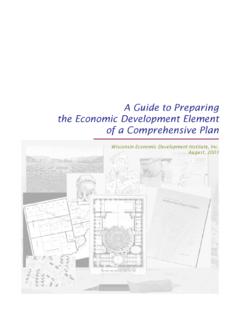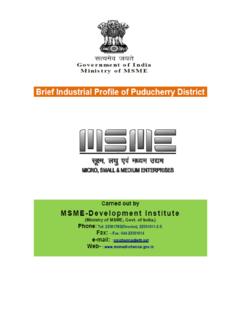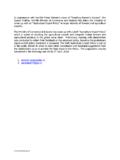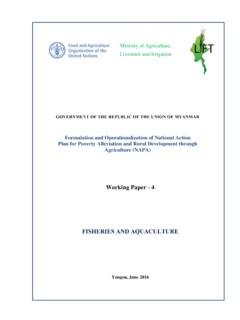Transcription of Evaluation of Forest Products Industry Cluster in ...
1 EEvvaalluuaattiioonn ooff FFoorreesstt PPrroodduuccttss IInndduussttrryy CClluusstteerr iinn WWiissccoonnssiinn AAnndd RReeccoommmmeennddaattiioonnss ffoorr EEccoonnoommiicc DDeevveellooppmmeenntt AAccttiioonnss OOccttoobbeerr 22000044 Project No.: 03-DG-11244225-478 This Report was Prepared Under an Award by the Northeastern Area State and Private Forestry, USDA Forest Service Roger M. Nacker Wisconsin economic development Institute, Inc. Evaluation of Forest Products Industry Cluster in Wisconsin and recommendations for economic development actions Table of Contents Introduction Defining the Forest Products Industry Cluster in Wisconsin What is a Cluster ?
2 1 Cluster Theory History Identifying a Cluster Location Quotient Shift-Share Analysis Clusters as an economic development Tool Forest Products Industry Clusters .. 5 Forest Products Industry Cluster Definition Wisconsin s Forest Industry Cluster Trends in the Forest Products Industry .. 10 Importance of the Wisconsin Forest Products Industry National Highlights Wisconsin Highlights Sustainable Forest Resource Highlights Industry Location Recent Forest Products Industry Changes .. 13 economic Downturn Paper Industry Trends .. 14 Overcapacity (nationally) Consolidation Globalization Capital Spending/Reinvestment Wood product Industry Trends .. 16 Primary Wood Products Secondary Wood Products Historical Perspective.
3 18 Forest Products Industry Cluster economic development Strategies Requirements .. 20 A Cluster Strategy in action Mobilization Diagnosis Collaborative Strategy Implementation Other State-Level Accomplishments .. 22 Rural Area economic development .. 23 Forest Products Industry Cluster SWOT .. 24 Industry Strengths Industry Weaknesses Industry Opportunities Industry Threats recommendations .. 25 Local economic development Effort Local economic development Effort Center for Sustainable Forestry Business Forest product Diversification Grant Program Finally References Appendix 2002 NAICS Matched to 1987 SIC for Wood product , Furniture and Paper Manufacturing Introduction Analysis and economic development action plans based on Industry clusters have become very popular in recent years.
4 However, much of this work has focused on high technology industries. Resource based clusters, such as what is widely perceived as the paper/forestry Cluster in Wisconsin, have not received the same attention. All communities cannot become high tech havens. What then? Resource-based clusters are usually associated with rural economies. Empirical studies of rural Industry clusters, when they exist, have shown that they generally contribute positively to regional economic growth, especially in employment and higher wages. This positive growth, however, is not a given and economic development issues must be addressed. Given the widespread and highly pervasive nature of the paper/forestry Cluster in Wisconsin, this report will explore what viability of the Cluster means for the economic health of the state, especially the northern half?
5 The goal of this report is to outline the utility of a Cluster approach for economic developers. Using the Wisconsin Forest product Industry Cluster as an example, the relative roles of Industry and government in fostering business success and in achieving sustainable economic develop will be examined. recommendations will be given to foster positive economic development activity in this Cluster Defining the Forest Products Industry Cluster in Wisconsin What is a Cluster ? Broadly defined, an Industry Cluster is a geographic concentration of similar and/or related firms that together provide competitive advantages for members of the Cluster and the area economy. These Industry clusters can consist of interconnected companies, specialized suppliers, service providers and associated institutions in a region and are the result of history, natural resource advantages and/or successful entrepreneurial cultures.
6 In recent years, numerous states and regions have adopted clusters as a new strategy for economic development . Cluster strategy is first and foremost, an economic development strategy. It provides a coordinated and efficient way to promote economic growth. (Munnich, et al, 1999). One viewpoint, which seems to give extra meaning to the term paper/ Forest Products Cluster , at least to natural resource scientists, is conveyed by the quote Clusters are economic ecosystems (Moore, 1993). Cluster Theory History economic development interest in clusters began in the early 1990s with the publication of Harvard professor Michael Porter's book The Competitive Advantage of Nations (1990).
7 Porter hypothesized that groups of similar, interrelated firms concentrated in a small geographic area gain a competitive edge when they have access to unique regional resources, are driven by demand and have achieved a threshold level of size. Even though competition may be intense, networks of buyers, sellers and service providers Wisconsin Paper/ Forest Products Cluster /2 encourage knowledge spillover a constant churning of ideas that leads to new Products and more efficient ways of producing existing Products . While the term clusters was new, the theory behind them was not. Spatial definition and analysis of Industry complexes goes back to the beginning of the twentieth century.
8 One of the earliest works is that of economist Alfred Marshall who looked at the specialized industrial districts of Europe at the end of the 19th century. Walter Isard in his comprehensive book, Methods of Regional Analysis, (published in 1960) also cites pioneering work done by Alfred Weber in 1929 and E. M. Hoover in the 1940 s. These works attributed Industry location groupings to economic factors such as transport cost differentials, labor cost differentials and other cost differentials, scale economics and localization and urbanization economies. Much of the interest in either Industry complexes or clusters remained with regional economists and economic geographers through the ensuing decades except when significant structural changes in the economy resulted from changes in major Industry sectors.
9 A prominent historical example is the migration of the textile Cluster from the northeastern United States to the Southeast. Precipitated by economic contraction in 1990, several states sought to capitalize on Porter s research and pioneered using the Cluster approach for economic development strategizing. Leaders among them were Arizona and Oregon. The same Cluster research boom also occurred in Europe at the same time. Identifying a Cluster In order to develop his theory, Porter had to come up with some techniques for defining and quantifying such clusters . Still, there is no one widely accepted way of identifying clusters. Some of the characteristics used to identify clusters are: Products , Processes, Value Chains, Technologies, Skills, and/or Resources.
10 Obtaining useable data or information, either hard or soft , to quantify clusters is expensive and time consuming, especially for sub-state regions, particularly counties. Rural counties are a focus of this problem. The data which is often used to measure employment usually comes from state gathered data called the Quarterly Census of Employment and Wages (QCEW, also know as ES-202) and/or its federal counterpart County Business Patterns. There is, however, a major problem with this data. In order to not divulge proprietary information, data is usually suppressed when less than three employers constitute a sector in a geographic area. For large employers in rural counties, this suppression obscures their important local economic role.







